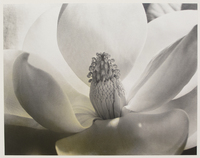Imogen Cunningham
1925
Silver gelatin photograph
Overall: 9 in. x 12 1/2 in.
Gift of Elena & Burton Glinn
Imogen Cunningham (1883-1976) was an American photographer known for her radical innovations in photography. Revolutionizing the idea of the blurry image, Cunningham along with several other well known photographers, asserted their identity as artists with the creation of the f/64 group in 1932.1 Their work focused on Pictorialism, a way of mystifying a work of art and giving it a broader view, allowing more interpretation and emotion.
From a young age Cunningham had a love for art, particularly photography. While her father did not want her to become a “dirty photographer” with her educational background, he still respected and even supported his daughter in pursuing her dreams. In 1903 Cunningham, respecting her father’s wishes, went to college and majored in chemistry at the University of Washington, not far from her home. Cunningham had become interested in photography in high school when she was introduced to the work of Gertrude Käsebier (1852-1934), particularly her print Blessed Art Thou Among Women (1899).2 Determined to begin her photography career, in 1901 Cunningham sent a letter with money to the International Correspondence School in Scranton, Pennsylvania. In return, she received a box containing a camera, an instructional book and an empty box to send in her photographs for examination. Soon afterward, Cunningham’s father constructed a darkroom in their shed, allowing her to further delve into the photography world. To pay for her photography expenses while at Washington, Cunningham worked as an assistant in the chemistry department where she made slides for the botanists. This is where Cunningham became fascinated with nature and the incredible detail within each plant.
After completing her studies at Washington, Cunningham worked for Edward S. Curtis's Seattle studio on his project of documenting American Indian tribes for the book The North American Indian, which was published in twenty volumes between 1907 and 1930.3 Cunningham learned the technique of platinum printing under Curtis’ supervision and became fascinated by the process. In 1909, Cunningham was awarded a grant from the Pi Beta Phi sorority at the University of Washington. This grant allowed her to work at the Technische Hochschule in Dresden where she helped the photographic chemistry department find cheaper solutions for the expensive and, at the time due to World War I, rare platinum used for printing.4 She published her work and returned to the U.S. where she began exhibiting her work in 1914 and continued working as an artist until her death.
The photograph in the collection at St. Mary’s, Magnolia Blossom (1925) a gelatin silver print, is a perfect example of Cunnigham’s work. This piece was a part of her exhibition in Stuttgart in 1929.5 Her cropping and use of angles draws the viewer into the center of the flower itself. She captures the essence of nature but furthermore lets the viewer dissect the image through the delicate shading, which directs the eye from the center and then leading outward. Cunningham utilized a softer lighting to create less intense shadows on the outer edges of the image and focus more on the details within the central stigma. The center of the flower draws the eye downward with swirling pistols, which is then connected to vertical arrow like anthers. From the bottom of the anthers the petals spring outward and upward, almost as if they are holding up the inner stigma. The petals give a feeling of protection to the central pistols and almost seem like guides for the viewer’s eye to the detail of the swirls. Cunningham’s work has revolutionized the photography world with her avant-garde style of photography. With her background in chemistry and her extensive work with botany, Cunningham presents her viewer with more than just an image of a flower. She brings together science and art in a way that is both beautiful as well as educational.
1. “Biography,” Imogen Cunningham Trust, Accessed December 1, 2016. https://www.imogencunningham.com/biography.↩
2. Richard Lorenz, Imogen Cunningham: Portraiture (Boston: Little, Brown, 1997)↩
3. Mary Street Alinder, Group f.64: Edward Weston, Ansel Adams, Imogen Cunningham, and the Community of Artists who Revolutionized American Photography (New York: Bloomsbury, 2014)↩
4. Christian A. Peterson, After The Photo-Secession: American Pictorial Photography, 1910-1955 (Minneapolis, MN: Minneapolis Institute of Arts, 1997↩
5. "Chronology," Imogen Cunningham Trust, Accessed March 16, 2017. https://www.imogencunningham.com/chronology↩
-Haley Sieglein

